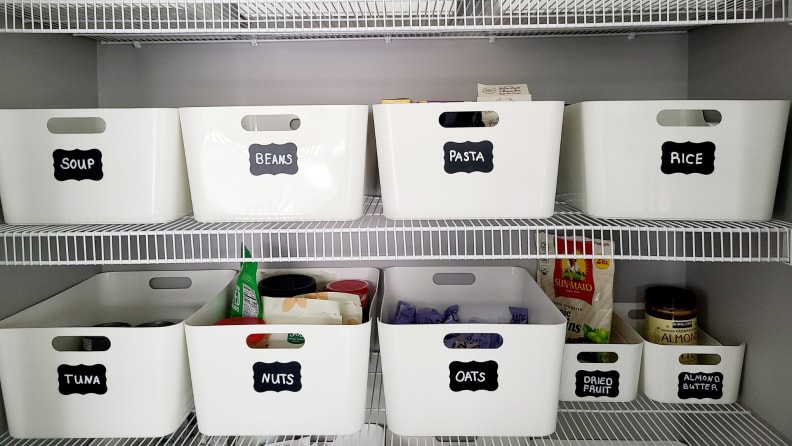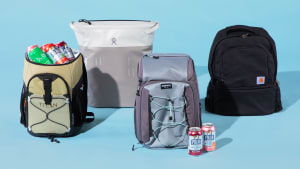 Credit:
Reviewed / Eden Strong / Utopia Home Store / Unopgo
Credit:
Reviewed / Eden Strong / Utopia Home Store / Unopgo
Recommendations are independently chosen by Reviewed's editors. Purchases made through the links below may earn us and our publishing partners a commission. Prices were accurate at the time this article was published but may change over time.
With a family of five that includes an endlessly snacking preschooler and an perpetually hungry teenager, the doors to our kitchen pantry are always open.
Our pantry is centrally located in our living space and with the doors open, the boldly colored cans, boxes, and bags of food make the space look messy and cluttered. It became such a pet peeve that I decided to organize my pantry.
When it comes to kitchen pantry organizing, I wasn’t sure where to begin, but to my surprise the entire project was fairly simple—and less expensive that I was estimating. Here’s how I organized my kitchen pantry for a family of five under $150.
1. Separate food into categories

It's easy to get overwhelmed when tackling a large project like this, but starting with categorizing can help you visualize where everything belongs.
Before I could even begin to figure out how I was going to tame the chaos, I needed to know what I was working with and that began with pulling everything out of the pantry. Yikes!
I couldn’t even believe how much food I had crammed in there, but once everything was out, I started separating the items into distinct categories and suddenly the project began to feel like one that I could actually manage.
Although some people choose to organize their pantry by packaging style, such as cans, boxes, or bags, I knew that, for my family, function was going to be the key, so I decided to separate my categories into how my family uses specific food items.
For example, my preschooler snacks on fruit cups, crackers, and raisins, so putting those items together and placing them low enough to be within his reach would be a huge help when his little hands and eyes are rummaging through the pantry looking for something to eat.
I also knew that I wanted sugary sweets to be up and out of sight, while I needed fresh produce to be right in my line of vision so that I would remember to use it before it spoiled.
I even went as far as to create groupings of meals that we make often; for example, by putting taco Tuesday supplies together, Crock Pot chili ingredients, and keeping pasta sauce with noodles, I would always know what full meals I had on hand.
2. Measure the pantry and plan your layout
I started by measuring my pantry to see how much space I had to work with. Then, I divided those measurements by the number of categories I had separated my food into.
One thing to keep in mind is that some categories may be larger than others, and therefore you’ll need to account for additional space here and there. I also factored in how many pantry shelves I have available for use.
Some quick math told me that I need at least three larger organizers, while the rest of my categories could fit into roughly the same size container. Of course, with the exception of utilizing a few smaller organizers for items that didn’t need a large amount of space.
Once I was able to get a better idea of how many organizers I would be looking to fit into my pantry and roughly what size they needed to be, I could get to shopping.
3. Shopping for (the right) organizers

Coordinate your entire pantry with specialized organizers for specific items, like cans and spices.
Food and pantry storage like clear containers, spice racks, and can organizers have many functional qualities, especially in walk-in pantries, which offer more privacy from a visual standpoint.
For my pantry, I opted for solid color organizers that hide the contents from view, but still have an open top to easily access what’s inside.
Full disclosure: I attempted this same project several years earlier but with bins that weren’t very durable, and ended up breaking after just a few months. So, while shopping for your pantry organizers, make sure to choose a product that feels sturdy and like it will last awhile.
Organizers like The Container Store's large plastic storage bins with handles are aesthetically pleasing, durable, and within my budget.
The storage bins also match a few other styles of stacking bins with lids that are perfect for the items in my pantry that I don’t use as often. Plus, who doesn’t love a lid to keep the dust bunnies at bay?
4. Label the bins

These chalkboard labels from Onupgo are reusable and can be easily changed, just in case you need to rearrange your pantry in the future.
Using a label maker to identify the contents of each bin is a lifesaver. This keeps the items in my pantry properly organized, making it easier for the whole family to know where to look and where to put something back.
I purchased the Onupgo Chalkboard Labels from Amazon, which includes a chalkboard marker. The labels stick to the bins just like a nametag (and are easily removed if needed).
Using the included water-erasable chalkboard marker, I wrote the categories on each label. I like that it’s erasable so that you can reuse it as needed. Another option is to use a label maker.
Kitchen pantry organizing tips
This is a project that I really wish I had done sooner. Not only do I get constant compliments from my guests (some have even taken pictures to replicate in their own homes), but it has made life so much easier.
The kids now grab the healthy snacks that are within their sight, while having dessert type foods up and out of the way has kept treats from being a thoughtless grab during the day. Grocery shopping goes so much quicker when a quick scan of the pantry alerts me to what is running low and I’m saving money because I’m not constantly buying items we already had (hello five bottles of ketchup).
But if organizing a pantry feels a little overwhelming, I am here to tell you that it can be managed.
Although separating your food into categories, measuring correctly, and shopping for organizers that are functional, durable, and aesthetically pleasing will assure your project to be a success, it’s important to remember that whatever you do can be changed and modified as needed.
In my pantry, I originally had all my chips, crackers, and pretzels together, until I realized that crackers needed to have their own designated space since we often have so many different varieties. I also added a “keto” bin which helped me focus diet specific items into one section, so that I didn’t have to dig my way through bins of non-ketogenic foods to find a certain type of snack.
Prepare, plan, and if needed, change it later! You got this.





